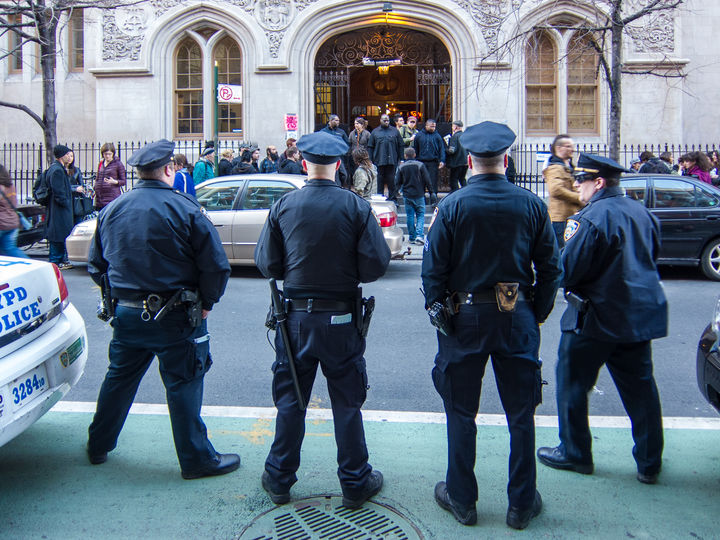Anarchy in the Lower East Side
New York, NY, USA
I’d noticed that there seemed to be more police than usual on the Lower East Side today, but until I turned onto Suffolk Street I hadn’t seen any who actually seemed to have some specific purpose. Perhaps they were just out enjoying the fine weather.
On Suffolk Street, however, they were out in visibly greater force. There was a small knot of uniforms, a whiteshirt, a van, and even a few helmeted scooter cops loitering on nearby Rivington. The focus of their attention seemed to be the Clemente Soto Vélez Cultural Center, which was surrounded by a small and slightly ragged-looking crowd.
I asked one of the bystanders if he knew what was going on. “It’s an anarchist book fair,”
he explained. “There’s certain people inside who have specific political ideas, and certain people outside who have other specific political ideas,”
he clarified. “And some of the people inside don’t want some of the people outside to come in.”
He said it in a tone that suggested that the problem was really one of specificity. If only they had had vague political ideas, like most Americans, none of this would have happened. “And now there’s forty cops round the corner, waiting to jump on them,”
he added. “Instead of standing around, those cops ought to actually read some of the books on sale inside. They might learn something.”
The picture painted by my informant was still rather vague, so I asked an older man if he could fill in the details. He explained that the problem was the presence of a group calling themselves National Anarchists. Apparently there was some question among the others – call them ‘vanilla’ anarchists – as to whether ‘national’ anarchism could actually be a ‘thing’. Reading between the lines, I finally understood that there was a widespread feeling that the National Anarchists might actually be National Socialists.
“And now it’s anarchy!”
I said brightly. The white-haired man gave me a look that said “You’re not taking this entirely seriously, are you?”
Fortunately for peace and order, the National Anarchists were being kept at arms length by a group of burly black men in black hoodies who stood four abreast on the steps of the Center. They looked conspicuously out of place in the midst of the mostly white crowd in their camouflage and safety-pins anarchist gear, and I suspected that they were mercenaries rather than true believers. If they had any specific political program, it was probably that this whole farrago needed to be over in the next few hours so that they could go on to their evening jobs as nightclub bouncers.
The security men had a piece of paper with photographs of all the undesirables who were to be kept out. Any time someone tried to enter the building, the bouncers would check their face against the paper before letting them in. At one point, the littlest bouncer was sent across the street to hand a copy of the paper to the white-shirted cop, who seemed unimpressed. It was not his job, his attitude suggested, to go arresting one set of anarchists just because another set of anarchists didn’t like them. I had the impression, however, that he wouldn’t mind arresting the entire pierced and tattooed pack of them if any trouble did break out. He strode back and forth along the street, arranging his forces like a general drawing up a small army, and quizzing the scooter cops about how much tear gas they’d remembered to bring with them.
I finally learned that there were actually National Anarchists present, represented by a long-haired gentleman wearing a green parka over what looked like a full-length khaki dress. He seemed rather put out that no one wanted to let him in and he was loudly but calmly arguing for his right to be admitted. When I first saw him, he was engaged in a debate with a tall individual whose face was entirely blue with tattoos. The tattooed man eventually tired of the argument, however, and his place was taken by a dapper young man in a broad-brimmed hat, a lace shirt-front and hose, who seemed to be enjoying himself immensely.
The debate, as far as I could tell, was civil, but it was clearly an unequal struggle. No one in the crowd was on Mr Green Parka’s side. He had been tried and convicted in the court of public opinion and his appeal was falling on deaf ears. The Fourth Musketeer, basking in the warmth of popular support, stroked his beard smugly and invited his adversary to explain again exactly how anarchism could be ‘national’.
Mr Green Parka rallied his strength for one last attempt. “I have never written anything anti-Semitic,”
he said. “Just because I’m against Antifa doesn’t make me a fascist. I am not a Nazi.”
Just then, a woman with a stroller tried to push through the crowd. “Hey, Nazi,”
a girl with dyed hair called out. “There’s a baby behind you.”
Mr Green Parka’s shoulders slumped and he sighed audibly.
When I left, they were still talking, their voices barely even raised. Across the road, the uniformed forces of the authoritarian state watched them suspiciously. You can never tell when trouble might flare up, their stance seemed to say. These anarchists are a violent lot.
